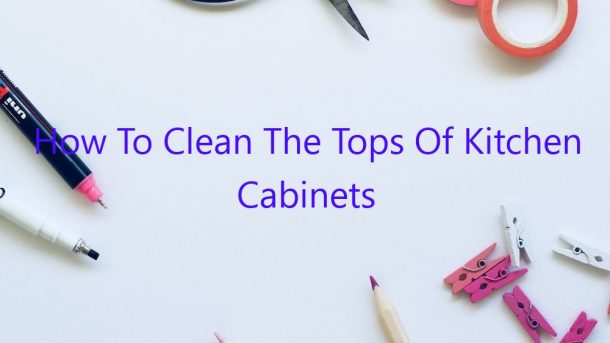The tops of kitchen cabinets are often overlooked when it comes to cleaning, but they can easily become dirty and stained. Here is a guide on how to clean the tops of kitchen cabinets.
The first step is to gather your supplies. You will need a cleaning solution, a cloth, a sponge, and a bucket.
The next step is to mix the cleaning solution. You can either use a commercial cleaner or make your own by mixing one part vinegar to one part water.
Once the cleaning solution is ready, dampen the cloth in it and wipe down the cabinet tops. Be sure to pay special attention to any areas that are dirty or stained.
If the cabinet tops are still dirty or stained after wiping them down with the cloth, use the sponge to apply the cleaning solution directly to the dirt or stain. Leave the sponge on the stain for a few minutes before wiping it off with the cloth.
Be sure to rinse the cloth and sponge in the bucket of water after each use and wring them out thoroughly.
Once the cabinet tops are clean, dry them with a clean cloth.
Contents
How do you get grease and dust off top of kitchen cabinets?
Cleaning the top of your kitchen cabinets can be a daunting task, but it’s important to keep them clean in order to maintain a healthy home. Grease and dust can accumulate over time and can be difficult to remove without the right tools and techniques.
One of the best ways to clean the top of your kitchen cabinets is to use a degreaser. A degreaser can help to break down the grease and dirt that has built up over time. Be sure to follow the instructions on the degreaser carefully, as overuse can damage the finish of your cabinets.
Another way to remove grease and dust from your cabinets is to use a dryer sheet. Simply wipe the top of the cabinets with a dryer sheet to remove the dirt and dust. This is a quick and easy way to clean your cabinets, and it’s a great way to use up old dryer sheets.
If you have a lot of grease and dirt on your cabinets, it might be necessary to use a cleaning solution. Be sure to test the cleaning solution on a small area of the cabinet first to make sure it doesn’t damage the finish.
Finally, be sure to wipe down your cabinets with a clean cloth to remove any remaining dirt or grease. This will help to keep your cabinets clean and sparkling.
Why are the tops of my cabinets sticky?
The tops of your cabinets may be sticky for a variety of reasons. Cleaning them with a mild detergent should take care of the problem.
If the cabinets are made of wood, the top may be sticky because of a build-up of dirt, grease, or wax. To clean, mix a solution of one part vinegar to three parts water. Wipe the solution onto the cabinets with a cloth, and then dry them with a clean cloth.
If the cabinets are made of plastic, the top may be sticky because of a build-up of dirt, dust, or grease. To clean, mix a solution of one part ammonia to four parts water. Wipe the solution onto the cabinets with a cloth, and then dry them with a clean cloth.
How do I clean the top of my dusty cabinets?
Dusty cabinets are a common problem, but they can be easily cleaned with some simple tips.
The first step is to gather the supplies you will need. You will need a vacuum cleaner, a duster, a wet cloth, and a dry cloth.
The next step is to vacuum the top of the cabinets. Use the crevice tool to get into the cracks and corners.
Then, use the duster to dust the top of the cabinets. Be sure to get into the cracks and corners.
Finally, use a wet cloth to clean the top of the cabinets and a dry cloth to dry them off.
How do you clean wood top cabinets?
Wooden cabinets are a popular choice for kitchen cabinetry. They are sturdy and look great, but they do require a bit of care to keep them looking their best. One of the most common problems with wooden cabinets is that they can get dirty and stained over time.
Fortunately, cleaning wood cabinets is a relatively easy process. You will need some basic supplies, including a cleaner, a soft cloth, and a water-dampened sponge. First, make sure to remove all of the contents of the cabinets and set them aside.
Next, use your cleaner to wipe down the cabinets. Be sure to get into all of the nooks and crannies, and pay special attention to the areas where dirt and dust tend to accumulate. Then, use the soft cloth to dry the cabinets.
Finally, use the sponge to dampen the cabinets and then use it to wipe away any remaining dirt or dust. Make sure to dry the cabinets again when you are finished.
Cleaning wood cabinets can be a bit time-consuming, but it is well worth the effort in order to keep your kitchen looking its best.
What is the best degreaser for kitchen cabinets?
If you’re like most people, you probably don’t think about the cleanliness of your kitchen cabinets until you start to notice a build-up of grease and grime. At that point, it’s usually time to take some action and clean them using a degreaser.
But what is the best degreaser for kitchen cabinets? And how do you use it effectively?
In order to answer those questions, it’s first important to understand what a degreaser is and what it does. A degreaser is a household cleaner that is specifically designed to remove grease, oil, and other stubborn dirt and stains. It can be used on a variety of surfaces, including kitchen cabinets.
When it comes to choosing a degreaser for kitchen cabinets, there are a few things to consider. The first is the type of degreaser. There are three main types: liquid, aerosol, and powder. Liquid degreasers are the most common type and come in a variety of forms, such as sprays, wipes, and soaps. Aerosol degreasers are also common and come in a spray can. They are easy to use but can be harmful if inhaled. Powder degreasers are less common but can be very effective. They come in a powder form that you mix with water before using.
The second thing to consider is the strength of the degreaser. Some degreasers are designed for light cleaning, while others are meant for tougher jobs. When choosing a degreaser, be sure to choose one that is strong enough for the job at hand.
The third thing to consider is the ingredients in the degreaser. Some degreasers contain harsh chemicals that can be harmful to your skin and lungs. If you have sensitive skin or are concerned about the safety of the ingredients, be sure to choose a degreaser that is gentle and safe to use.
Once you’ve chosen a degreaser, it’s time to get to work. The best way to use a degreaser is to read the instructions carefully and follow them closely. In general, you will want to apply the degreaser to the surface and let it sit for a few minutes before rinsing it off. Be sure to wear gloves and eye protection when using a degreaser, and keep it out of the reach of children.
When it comes to choosing the best degreaser for kitchen cabinets, there is no one-size-fits-all answer. However, by considering the type of degreaser, the strength of the degreaser, and the ingredients in the degreaser, you can choose the best one for your needs.
Why are my kitchen cabinets sticky after cleaning?
If your kitchen cabinets are sticky after cleaning, you’re not alone. This is a common problem that can be caused by a variety of factors. In this article, we’ll discuss the possible causes of kitchen cabinet stickiness and how to fix it.
One possible cause of kitchen cabinet stickiness is dirty cabinets. If your cabinets are not clean, the dirt and grease can cause them to become sticky. To fix this, you’ll need to clean your cabinets using a degreaser or a mild detergent.
Another possible cause of kitchen cabinet stickiness is excess moisture. If your cabinets are not properly dried after cleaning, the moisture can cause them to become sticky. To fix this, you’ll need to make sure your cabinets are completely dry before closing them.
A final possible cause of kitchen cabinet stickiness is the use of the wrong cleaning products. If you’re using a cleaning product that contains silicone, it can cause your cabinets to become sticky. To fix this, you’ll need to use a cleaning product that does not contain silicone.
If your kitchen cabinets are sticky after cleaning, the best way to fix the problem is to identify the cause and take appropriate action. By following the tips in this article, you can help keep your cabinets clean and free of stickiness.
How do you clean kitchen cabinets without removing the finish?
Cleaning kitchen cabinets without removing the finish may seem difficult, but it can actually be quite easy. All you need is a little bit of patience and some basic supplies.
The first step is to gather your supplies. You will need a cleaning agent, a soft cloth, and a toothbrush. You may also want to use a sealant to protect your cabinets from future dirt and dust.
Next, use your cleaning agent to wipe down your cabinets. Be sure to avoid any areas that may be damaged or sealed. If your cabinets are particularly dirty, you may need to use a toothbrush to get into the nooks and crannies.
Finally, use a soft cloth to polish your cabinets and remove any excess cleaning agent. If you choose to use a sealant, be sure to apply it evenly to all of the surfaces.
Your cabinets should now be clean and protected from future dirt and dust.




